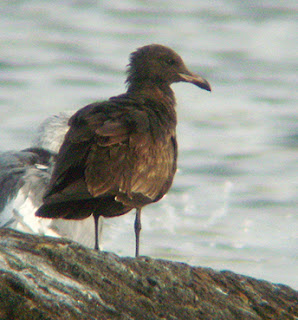Having decided not to join the big pelagic trip off the west coast of the island today (around 100 birders on one large vessel, bobbing up and down on the ocean waves? Not for me.), I headed out early this morning to see what comparatively few seabirds I could locate off Clover Point...
The first thing that was apparent was the huge number of gulls feeding offshore.
There were probably a couple of thousand birds, and one bait ball alone was simply teeming with several hundred birds. Rather annoyingly, the rising sun was right behind them and getting a decent look at was in the mix was a touch tricky. Needless to say, I couldn't pick out anything notably unusual among the throng.
All around the point there were larids, mostly California, glaucous-winged and mew gulls, as to be expected, but a considerable increase in the number of Thayer's gulls too.
Several Heermann's gulls were also in the area, and just lately the number of 1st winter birds (rather scruffy individual pictured) has started to really build up.
When out at sea, these very dark, slender gulls can really look like jaegers (or skuas, as we Brits birders would have it) - particularly parastic (Arctic).
When Ian Cruikshank mentioned this to me a few months ago, before I'd really had any experience of viewing distant 1stW Heermann's, I found it rather hard to swallow, but as I have discovered recently their overall jizz can really suggest those piratical seabirds.
I've followed more than a few in recent weeks only to be disappointed!
As it happens, no jaegers were attracted to the feeding mass of gulls in the two hours or so, that I was down there this morning.
Aside of the gulls, other stuff offshore included good numbers of common murre, several pigeon guillemots, a couple of marbled murrelets, and a red-necked grebe (pictured, with customary lack of skill), up to 3 horned grebe, 11 surf scoter and 3 harlequin ducks.
Shorebirds were fairly thin on the ground, with just 3 surfbirds and 10 black turnstone, 1 black oystercatcher seen, plus 4 fly-by least sandpipers.
Visible migration was pretty uneventful too, with just 3 southbound American pipit and around a dozen barn swallows heading out toward the USA.
At one point I heard a killdeer, but I have no idea whether it was flying through undetected, or was simply lurking somewhere out of sight.
The regular mink was busy weaseling around in search of grub.
So, now I'm just waiting to hear about the amazing seabirds that a percentage of those seafaring birders bagged out in the Pacific today... I feel a bout of envy and regret coming on.



No comments:
Post a Comment